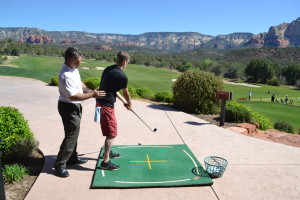 In our last blog, we got some valuable tips from Seven Canyons Lead Golf Pro, Dave Bisbee, on how to start out the year building your swing. This post is designed to address building a strong body foundation using stabilization exercises and manual therapy to correct restrictions in the body, to improve golf performance. I hope you have checked the Titleist Performance Institute website by now to check out their great information and evaluated yourself with the basic movement tests (www.tpi.com/articles/screening).
In our last blog, we got some valuable tips from Seven Canyons Lead Golf Pro, Dave Bisbee, on how to start out the year building your swing. This post is designed to address building a strong body foundation using stabilization exercises and manual therapy to correct restrictions in the body, to improve golf performance. I hope you have checked the Titleist Performance Institute website by now to check out their great information and evaluated yourself with the basic movement tests (www.tpi.com/articles/screening).
In a nutshell our basic movement strategy is built from the ground up with alternating platforms of stability and mobility. For many of us the combination of a long winter and more sedentary lifestyle has decreased our mobility and skill sets needed for specific activities. The effects of prolonged sitting and static postures alone can lead to muscle imbalances that are extremely detrimental to the golf swing. One of the most common imbalances shows a combination of tight lower back muscles (Quadratus Lumborum & Erector Spinae) with tight hip flexors (Iliopsoas). The more we sit our brain will shut down or inhibit our deep core (Transverse Abdominus and Glutes) and call in other muscles like the hamstrings to aid the back muscles in maintaining stability thus weakening our golf foundation making us vulnerable to low back and other injuries.
I cannot stress enough the importance of proper engagement of our deep core. In working with many golfers over the past few months I have found many people who only engage the more superficial abdominal muscles (Rectus Abdominus -“six pack”- and the Obliques) but completely bypass the Transverse Abdominus – the cornerstone of core stability. To check your deep core stability check your ability to perform a “pelvic tilt test”, “pelvic rotation test” and “trunk rotation test” (see TPI screens). If your quality of movement is limited or if movement improves when someone assists with stabilizing your thorax for pelvic tests or vise versa for thoracic rotation, then you test positive for decreased deep core stabilization and the focus of your workouts should begin there.
Improper engagement of our deep core usually leads to recruitment of other muscles and changes our biomechanics with activities. The more we require of our bodies with activity in terms of quantity of movement or refined skill sets, the more proper biomechanics role in performance and injury prevention. That being said, proper biomechanics is a key component in acute and chronic pain prevention with all our daily routines.
If you want to find out if your core is leading to muscle imbalances, pain or decreased sport performance call us today! 512-695-8676
Michael Rende OTR, TPI-MP3
Leave a Reply